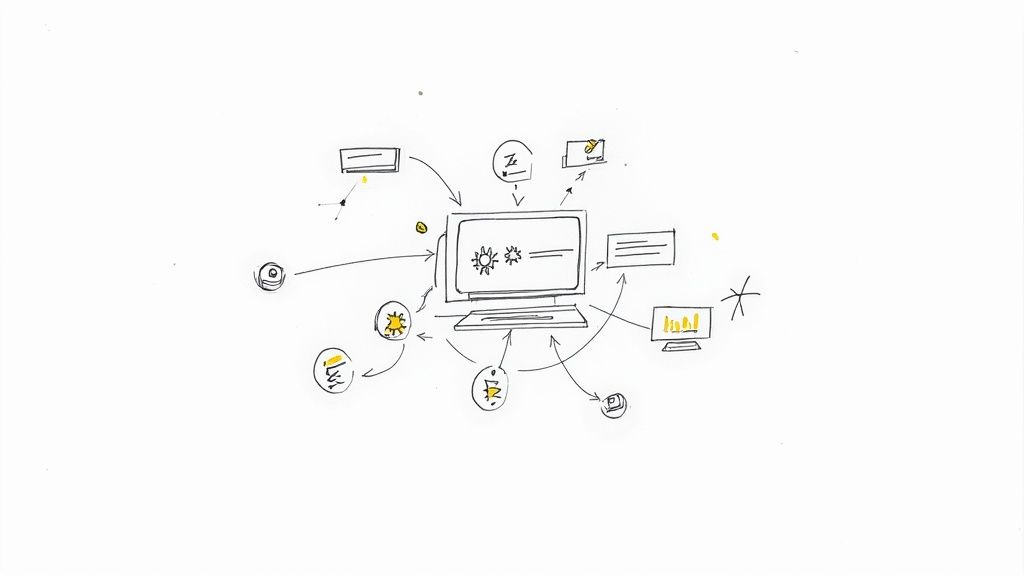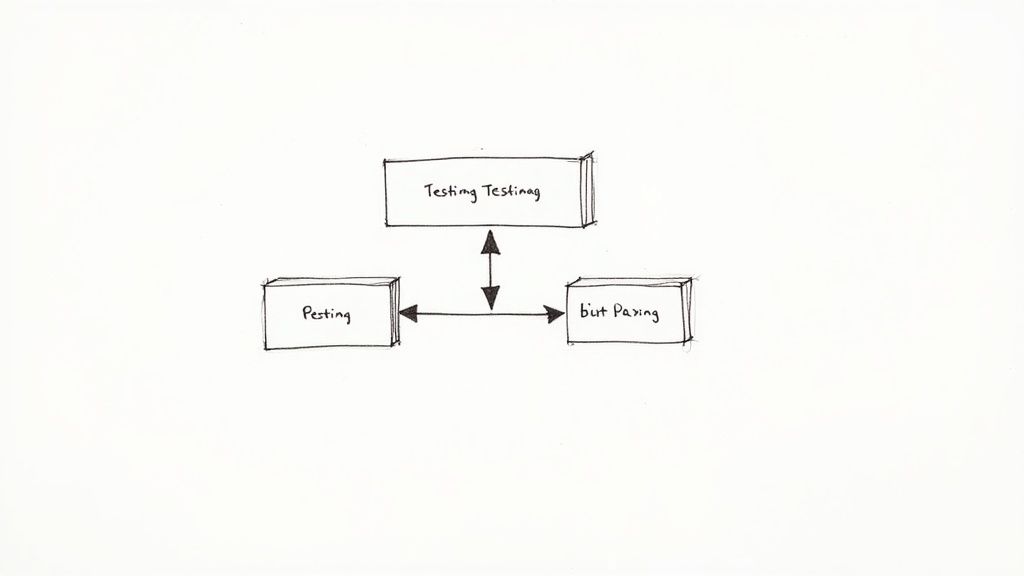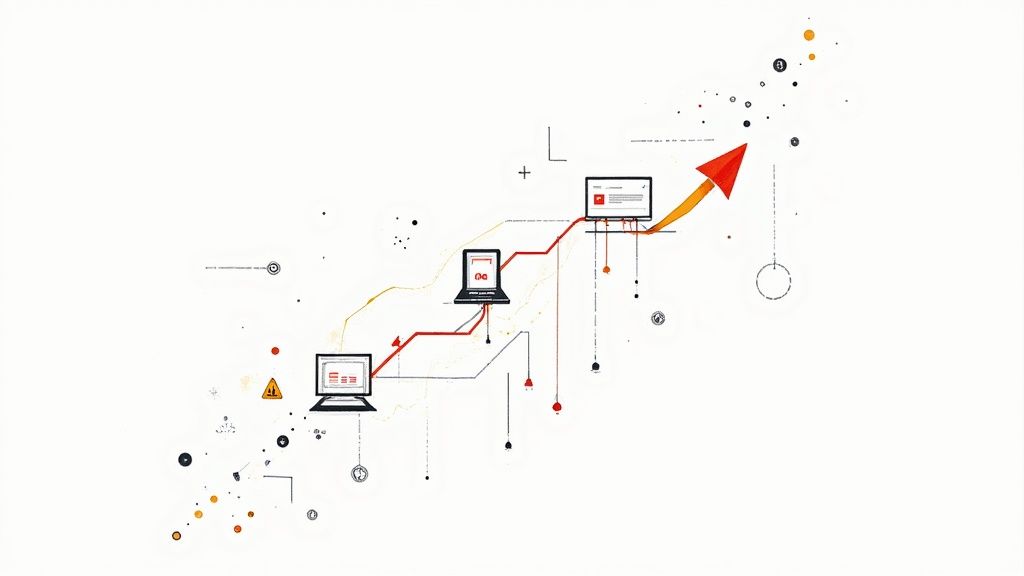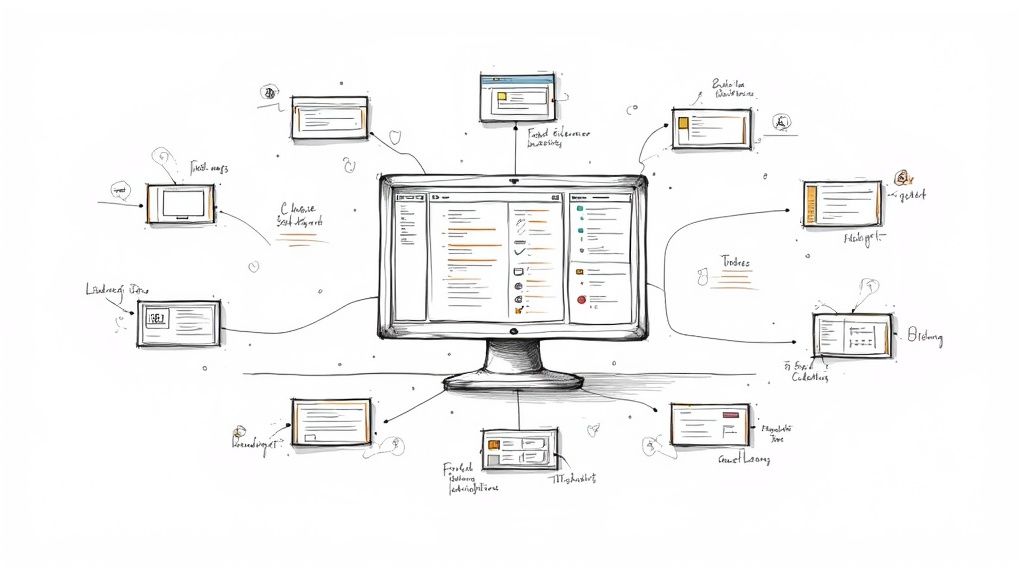Automated Regression Testing: Boost Quality & Cut Costs

The Evolution of Automated Regression Testing

The software development world has changed significantly over the last few decades. Early on, manual testing was the standard, a process often slow and prone to errors. This method struggled to handle the growing complexity of software and the demand for faster releases. This challenge led to the rise of automated regression testing, a crucial tool for modern development teams. Automated regression testing makes sure new code doesn't introduce bugs or affect existing features.
From Manual to Automated: A Necessary Shift
The shift to automated regression testing came from a real need. Testing a large application by hand after every code change is simply not feasible. Automation enables frequent and thorough testing, catching problems early in development. This not only saves time and resources but also greatly improves the software's quality.
For example, consider a team updating an e-commerce site. Automated regression tests could automatically check that core features, like adding items to a cart, processing payments, and managing user accounts, still work correctly after each code update.
This change reflects a broader industry trend toward automation. For insights into the future of AI in marketing, see this article on the future of PPC in an AI-driven world. This highlights the growing importance of automation across various sectors. This natural progression frees up teams to focus on strategic work, leading to innovation and ongoing improvement.
By the early 2000s, manual testing was clearly inadequate for increasingly complex software. Advancements in technology allowed automated regression testing to meet these challenges. Today, it’s vital for ensuring code changes don't create bugs or break existing features, fitting seamlessly with modern practices like Continuous Integration/Continuous Deployment (CI/CD). Over 73% of testers utilize automation for functional and regression testing, and 60% of companies see a positive Return on Investment (ROI) from its implementation. This efficiency is key for delivering high-quality software quickly, a necessity in today's competitive landscape. Learn more about automated software testing here.
Key Benefits of Automated Regression Testing
Automated regression testing offers several important benefits:
- Increased Speed and Efficiency: Tests run automatically, significantly reducing testing time compared to manual methods.
- Improved Accuracy: Automated tests eliminate human error, providing consistent test execution.
- Early Bug Detection: Problems are found early in development, minimizing the cost and effort of later fixes.
- Enhanced Test Coverage: Automation allows for more extensive testing, exploring diverse scenarios and edge cases.
- Seamless CI/CD Integration: Automated tests fit smoothly into CI/CD pipelines, supporting continuous testing and faster releases.
These advantages contribute to better software quality, quicker time-to-market, and lower development costs. This makes automated regression testing not just a good practice, but a fundamental requirement for modern software development. The evolution continues, with AI and machine learning becoming increasingly important, suggesting even more advanced and effective testing approaches for the future.
The Real ROI of Automated Regression Testing

Automated regression testing is increasingly important in software development. But what's the actual return on investment? Beyond the buzz, what tangible advantages do teams gain? The answer lies in how automation transforms time-consuming testing into a competitive edge.
Time Savings and Increased Efficiency
One of the most immediate benefits is the significant time savings. Manual regression testing can become a bottleneck, especially with complex software. Automated tests, however, can run continuously without human intervention.
This allows teams to receive faster feedback on code changes, accelerating development. QA professionals are freed up for more strategic work, like exploratory testing. This efficiency boost reduces costs by optimizing resource allocation.
For example, manually testing a complex web application could take days after every code update. Automated regression testing could execute the same tests in mere hours, or even minutes.
Improved Quality and Reduced Risk
Automated testing doesn't just save time; it improves software quality. Automated tests are consistent and precise, eliminating human error that can plague manual testing. This leads to more accurate defect identification.
Automated tests can also cover more scenarios and edge cases. This ensures more thorough testing and reduces the risk of critical bugs in production. This broader coverage creates a more robust and reliable final product.
Finding bugs early through automated testing also significantly lowers the cost of fixing them. Addressing bugs later, especially post-release, can be exponentially more expensive.
This leads to the industry's growing reliance on automation. 77% of companies now use automated software testing, with 72% adopting continuous testing. Find more detailed statistics here. This shows the widespread recognition of automation's strategic and financial benefits. The automated testing market's projected growth, with a 19.2% CAGR expected from 2021 to 2026, further emphasizes this.
Building a Compelling Business Case for Automation
Justifying investment in automated regression testing requires a solid business case. Focus on key metrics like the cost of tools and implementation. But also highlight long-term benefits like reduced development costs, faster time-to-market, improved quality, and greater customer satisfaction.
To help illustrate these benefits, let's look at a direct comparison:
ROI Comparison: Manual vs. Automated Regression Testing
A detailed comparison of costs, time investment, and quality outcomes between manual and automated regression testing approaches
| Metric | Manual Testing | Automated Testing | Percentage Improvement |
|---|---|---|---|
| Time to Execute Tests | 48 hours | 4 hours | 92% |
| Number of Test Cases Executed | 200 | 1000 | 400% |
| Defects Found | 10 | 25 | 150% |
| Cost per Defect | $1000 | $200 | 80% |
As this table shows, automated testing provides significant improvements across the board. The time savings are dramatic, allowing for more frequent testing and faster release cycles. The increased number of test cases leads to more thorough coverage and the identification of more defects. While the initial investment in automation might seem higher, the reduced cost per defect quickly demonstrates the long-term financial benefits.
By quantifying these advantages, teams can clearly demonstrate the positive impact on the bottom line. This simplifies securing buy-in from decision-makers and justifies expanding automation.
The real ROI of automated regression testing lies in its ability to transform software development. By catching issues early and improving quality, automation empowers teams to deliver better software, faster. This translates to real business value: increased customer satisfaction, reduced costs, and a stronger competitive edge.
Choosing Your Automated Regression Testing Arsenal

Picking the right automated regression testing tools can be daunting. This section simplifies the process, emphasizing practical experience over marketing jargon. We'll compare top frameworks and discuss how they handle real-world testing scenarios.
Key Considerations When Selecting a Framework
Several factors are crucial when choosing an automated regression testing framework. These considerations will help you identify tools that meet your project's specific needs and align with your team's existing skills.
- Programming Language Support: A framework should support your team's programming languages. This is essential for efficient development and ongoing maintenance.
- Ease of Use and Learning Curve: Consider how quickly your team can adopt the tool. A steep learning curve can significantly impact project timelines and productivity.
- Cross-Browser Compatibility: For web application testing, ensure the framework supports all your target browsers. This ensures consistent functionality across different platforms.
- Community Support and Documentation: Good documentation and an active community forum are invaluable resources. They can significantly reduce troubleshooting time and improve efficiency.
- Integration with CI/CD: Seamless integration with your CI/CD pipeline is essential for continuous testing. Tools like Mergify can automate this process, triggering regression tests with every code change. This enables early bug detection and faster resolution.
- Cost: Evaluate both upfront and ongoing maintenance costs. While open-source tools might seem appealing, factor in potential hidden costs like training and support.
Comparing Leading Frameworks
To help you evaluate different options, we've compiled a comparison of popular automated testing frameworks. The following table provides a detailed overview of their key features, supported programming languages, and ideal use cases.
Comparison of Leading Automated Testing Frameworks
Overview of popular automated testing frameworks with their key features, programming language support, and ideal use cases
| Framework | Primary Language | Learning Curve | Web Support | Mobile Support | API Testing | Best For |
|---|---|---|---|---|---|---|
| Selenium | Java, Python, C#, Ruby, JavaScript, Kotlin | Moderate | Excellent | Via Appium | Yes | Web applications, cross-browser testing |
| Cypress | JavaScript | Easy | Excellent | No | Yes | Web applications, end-to-end testing |
| TestComplete | JavaScript, Python, VBScript, JScript, DelphiScript, C++Script, C#Script | Moderate | Excellent | Yes | Yes | Desktop, web, and mobile applications |
| Appium | Java, Ruby, Python, PHP, JavaScript, C# | Moderate | Via Selenium | Excellent | Yes | Mobile applications, cross-platform testing |
This table highlights the strengths and weaknesses of each framework. For instance, Selenium offers excellent cross-browser support but has a moderate learning curve. Cypress excels at end-to-end web application testing but lacks native mobile support.
Building Your Testing Framework
Choosing the right tools is just the beginning. Designing a maintainable testing framework is crucial for long-term success. Modular and reusable test components minimize technical debt and simplify updates as your application grows.
Effective test data management is also essential. A test environment that closely resembles your production environment improves the accuracy of your tests, ensuring they reflect real user scenarios.
Automated regression testing is a powerful way to improve software quality and speed up development cycles. Selecting the right tools and building a maintainable framework maximizes the effectiveness of your tests. The table above illustrates the importance of carefully evaluating each automation tool. This selection is the first step in successfully implementing automated regression testing. By considering your project needs and team's skills, you can choose the right tools to deliver high-quality software efficiently. Integrating your chosen framework with your CI/CD pipeline further optimizes the process and accelerates development workflows.
Integrating Automated Regression Tests Into CI/CD

Integrating automated regression testing into your CI/CD pipeline is essential for staying competitive. This section explores how to seamlessly incorporate these tests into your workflow for maximum impact. The ultimate aim is to make testing a development asset, not a roadblock.
Building a Robust and Efficient Pipeline
Effective integration depends on well-designed test suites that provide valuable feedback without causing delays. Think of your CI/CD pipeline as a finely tuned engine. Automated regression testing, like any other component, must operate smoothly without slowing down the system.
- Test Prioritization: Begin by testing the most critical functionalities. Focus on core features, recent code changes, and areas prone to bugs. This ensures that the most important elements are thoroughly tested with each build.
- Parallelization: Running tests simultaneously drastically reduces total testing time. It's like having multiple cooks in a kitchen – the work gets done much faster. By distributing the workload, you can significantly shorten the testing cycle.
- Selective Execution: Instead of testing the entire application for every change, run only the tests relevant to the specific code modification. This targeted approach eliminates unnecessary testing and focuses on potential problem areas.
Implementing With Leading CI/CD Tools
Choosing the right tools is crucial, similar to selecting the best recruitment automation software tools. For automated testing, selecting the appropriate tools is equally important. Let's look at integrating automated tests with popular platforms like Jenkins, GitHub Actions, and CircleCI.
- Jenkins: Jenkins offers plugins and integrations with testing frameworks for seamless test execution during builds. It provides centralized test management, result tracking, and the ability to automatically trigger builds after code commits.
- GitHub Actions: GitHub Actions streamlines automation by enabling you to define test workflows directly within your repository. This close integration allows automated tests to run seamlessly alongside builds, deployments, and other processes.
- CircleCI: CircleCI offers a cloud-based CI/CD platform supporting automated testing across various environments and frameworks. Its highly configurable nature provides flexibility and scalability as your project grows.
Practical Techniques for Optimization
Successful CI/CD integration relies on optimizing test execution for speed and dependability. These strategies ensure rapid feedback and consistent results, further enhancing the development process.
- Optimize Test Data Management: Realistic test data is paramount. Efficiently create, manage, and clean up test data to avoid compromising test performance or accuracy.
- Address Flaky Tests: Inconsistent tests that yield unreliable results waste time and resources. Identify and promptly fix these flaky tests to maintain your test suite's integrity.
- Monitor and Analyze Results: Regularly review test results to uncover areas for improvement and monitor overall test performance. Data-driven insights can highlight potential issues and inform future optimization efforts.
By implementing these strategies, automated regression testing becomes a core part of your CI/CD pipeline, enabling you to deliver higher-quality software faster. This proactive approach embeds testing throughout the development lifecycle, leading to more efficient resource use, quicker releases, and increased user satisfaction.
Beyond The Basics: Advanced Regression Testing Tactics
Automated regression testing is more than simply rerunning your existing tests. To really get the most out of it, consider these advanced tactics. They can significantly improve the quality and resilience of your software.
Visual Regression Testing: Catching UI Inconsistencies
Visual regression testing looks for unintended changes in your user interface. Imagine changing the font size of a heading and accidentally misaligning other elements on the page. Standard automated tests might miss this, but visual regression testing won't. Tools like Percy capture screenshots of the UI and compare them against baseline images, highlighting any differences. This ensures a consistent user experience and catches visual glitches that functional tests might overlook.
- Benefits of Visual Regression Testing:
- Identifies subtle UI changes
- Improves the overall user experience
- Reduces manual visual checks
This is especially helpful for applications with complex user interfaces where small changes can significantly impact the user experience. Integrating visual regression testing into your pipeline with tools like Mergify can automate this process, guaranteeing UI consistency with every code change.
Contract Testing: Verifying API Integrity
Modern applications often depend on APIs to communicate. Contract testing confirms that these interactions stay consistent. It's like a formal agreement between two parties (two services communicating via an API). This contract defines the expected data format and behavior. If either side changes its interaction, the contract test will fail, alerting teams to potential integration problems. This lets independent teams confidently develop and deploy their services, knowing their integrations remain stable.
- Benefits of Contract Testing:
- Ensures API consistency and reliability
- Facilitates independent development
- Quickly isolates integration issues
Contract testing is crucial for maintaining inter-service compatibility in complex microservice architectures. Tools like Pact can be helpful for implementing contract testing.
Performance Regression Testing: Preventing System Slowdowns
Code changes can accidentally impact performance. Performance regression testing tracks key performance metrics, such as response times and resource usage. This identifies bottlenecks and ensures that new code doesn't degrade performance. Think of it as regular maintenance on your car's engine. By establishing baseline performance metrics, teams can quickly detect deviations and fix performance issues before they affect users.
- Benefits of Performance Regression Testing:
- Maintains system responsiveness and efficiency
- Identifies performance bottlenecks
- Prevents slowdowns caused by code changes
This proactive approach is essential for applications where performance is critical. Tools like k6 can be used for performance testing.
Handling Complex Test Scenarios
Traditional automated tests can struggle with complex systems like databases, third-party integrations, or legacy components. Advanced methods like service virtualization let teams simulate these dependencies, allowing for controlled and repeatable tests. This is especially useful for testing integrations with systems that are hard to access or manage, such as payment gateways or external APIs. By isolating the application under test, teams can focus on its behavior and find problems without external limitations. This delivers better test coverage and quicker feedback, resulting in more dependable software. Hoverfly is an example of a service virtualization tool.
By implementing these advanced strategies, teams can go beyond basic automated regression testing to create a more thorough and effective testing process. This results in higher quality software, faster releases, and increased confidence in deployments.
The Future: AI-Powered Automated Regression Testing
Automated regression testing is constantly evolving. Artificial intelligence (AI) is set to reshape how quality assurance (QA) teams work, offering exciting new possibilities. Let's explore how AI is changing software testing.
Self-Healing Tests: Adapting to Change
AI algorithms can dynamically update tests when the application being tested changes. This self-healing ability tackles the problem of brittle tests that break easily with small UI changes. For example, if a button's ID changes, the AI can find the new ID and update the test script, saving time and effort. This adaptability ensures consistent and reliable testing. It also significantly reduces test maintenance, a major challenge in traditional automated testing.
Intelligent Test Generation: Expanding Coverage
AI can analyze application code and user behavior to generate test cases automatically. This intelligent test generation expands test coverage beyond manually created scripts. The AI pinpoints high-risk areas, potentially uncovering edge cases that human testers might miss. This automated approach can improve overall software quality by focusing on specific areas for improvement.
Predictive Analytics: Anticipating Issues
Imagine predicting bugs before they happen. AI-powered predictive analytics can analyze historical testing data and development patterns to identify areas likely to have problems. By proactively targeting these areas, teams can prevent defects before release, saving time and resources. This predictive ability shifts regression testing from reactive to proactive, significantly improving software quality.
The integration of advanced technologies like AI is transforming automated regression testing. AI-driven visual regression testing, with its improved anomaly detection, is gaining popularity. Tools like Applitools and Percy are leading this trend, and wider adoption is expected. Explore this topic further. The shift-left testing approach incorporates regression testing earlier in development, improving integration with CI/CD pipelines. This helps teams catch visual bugs earlier.
Preparing for the AI-Powered Future
The future of automated regression testing is clearly AI-driven. While some technologies are still developing, others offer real value today. To prepare, start by assessing your current testing procedures. Find areas where AI can have the biggest impact. Consider tools and frameworks with AI capabilities. Finally, train your team to use these new technologies. By embracing AI, you can prepare your team for success in the evolving world of software testing. Features like real-time bug prioritization, powered by AI enhancements to automation frameworks, are expected to become commonplace.
Ready to improve your development workflow and enhance your CI/CD pipeline with AI? Mergify offers intelligent merge automation, simplifying complex development processes and reducing CI costs. Explore the benefits of Mergify today.





